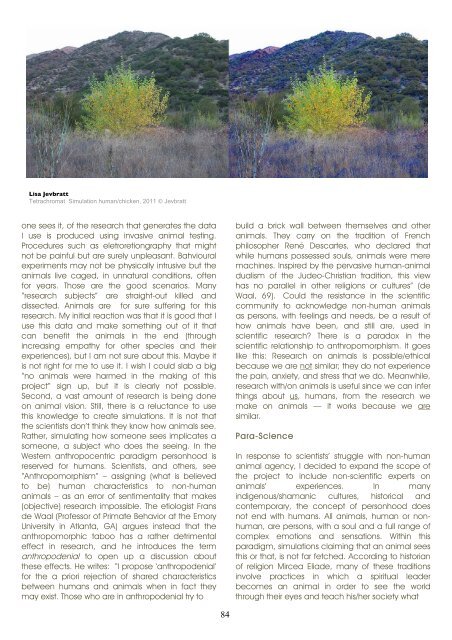Animal Influence I - Antennae The Journal of Nature in Visual Culture
Animal Influence I - Antennae The Journal of Nature in Visual Culture
Animal Influence I - Antennae The Journal of Nature in Visual Culture
Create successful ePaper yourself
Turn your PDF publications into a flip-book with our unique Google optimized e-Paper software.
Lisa Jevbratt<br />
Tetrachromat Simulation human/chicken, 2011 Jevbratt<br />
one sees it, <strong>of</strong> the research that generates the data<br />
I use is produced us<strong>in</strong>g <strong>in</strong>vasive animal test<strong>in</strong>g.<br />
Procedures such as eletroretiongraphy that might<br />
not be pa<strong>in</strong>ful but are surely unpleasant. Bahvioural<br />
experiments may not be physically <strong>in</strong>trusive but the<br />
animals live caged, <strong>in</strong> unnatural conditions, <strong>of</strong>ten<br />
for years. Those are the good scenarios. Many<br />
“research subjects” are straight-out killed and<br />
dissected. <strong>Animal</strong>s are for sure suffer<strong>in</strong>g for this<br />
research. My <strong>in</strong>itial reaction was that it is good that I<br />
use this data and make someth<strong>in</strong>g out <strong>of</strong> it that<br />
can benefit the animals <strong>in</strong> the end (through<br />
<strong>in</strong>creas<strong>in</strong>g empathy for other species and their<br />
experiences), but I am not sure about this. Maybe it<br />
is not right for me to use it. I wish I could slab a big<br />
“no animals were harmed <strong>in</strong> the mak<strong>in</strong>g <strong>of</strong> this<br />
project” sign up, but it is clearly not possible.<br />
Second, a vast amount <strong>of</strong> research is be<strong>in</strong>g done<br />
on animal vision. Still, there is a reluctance to use<br />
this knowledge to create simulations. It is not that<br />
the scientists don’t th<strong>in</strong>k they know how animals see.<br />
Rather, simulat<strong>in</strong>g how someone sees implicates a<br />
someone, a subject who does the see<strong>in</strong>g. In the<br />
Western anthropocentric paradigm personhood is<br />
reserved for humans. Scientists, and others, see<br />
“Anthropomorphism” – assign<strong>in</strong>g (what is believed<br />
to be) human characteristics to non-human<br />
animals – as an error <strong>of</strong> sentimentality that makes<br />
(objective) research impossible. <strong>The</strong> etiologist Frans<br />
de Waal (Pr<strong>of</strong>essor <strong>of</strong> Primate Behavior at the Emory<br />
University <strong>in</strong> Atlanta, GA) argues <strong>in</strong>stead that the<br />
anthropomorphic taboo has a rather detrimental<br />
effect <strong>in</strong> research, and he <strong>in</strong>troduces the term<br />
anthropodenial to open up a discussion about<br />
these effects. He writes: “I propose ‘anthropodenial’<br />
for the a priori rejection <strong>of</strong> shared characteristics<br />
between humans and animals when <strong>in</strong> fact they<br />
may exist. Those who are <strong>in</strong> anthropodenial try to<br />
84<br />
build a brick wall between themselves and other<br />
animals. <strong>The</strong>y carry on the tradition <strong>of</strong> French<br />
philosopher René Descartes, who declared that<br />
while humans possessed souls, animals were mere<br />
mach<strong>in</strong>es. Inspired by the pervasive human-animal<br />
dualism <strong>of</strong> the Judeo-Christian tradition, this view<br />
has no parallel <strong>in</strong> other religions or cultures” (de<br />
Waal, 69). Could the resistance <strong>in</strong> the scientific<br />
community to acknowledge non-human animals<br />
as persons, with feel<strong>in</strong>gs and needs, be a result <strong>of</strong><br />
how animals have been, and still are, used <strong>in</strong><br />
scientific research? <strong>The</strong>re is a paradox <strong>in</strong> the<br />
scientific relationship to anthropomorphism. It goes<br />
like this: Research on animals is possible/ethical<br />
because we are not similar; they do not experience<br />
the pa<strong>in</strong>, anxiety, and stress that we do. Meanwhile,<br />
research with/on animals is useful s<strong>in</strong>ce we can <strong>in</strong>fer<br />
th<strong>in</strong>gs about us, humans, from the research we<br />
make on animals — it works because we are<br />
similar.<br />
Para-Science<br />
In response to scientists’ struggle with non-human<br />
animal agency, I decided to expand the scope <strong>of</strong><br />
the project to <strong>in</strong>clude non-scientific experts on<br />
animals’ experiences. In many<br />
<strong>in</strong>digenous/shamanic cultures, historical and<br />
contemporary, the concept <strong>of</strong> personhood does<br />
not end with humans. All animals, human or nonhuman,<br />
are persons, with a soul and a full range <strong>of</strong><br />
complex emotions and sensations. With<strong>in</strong> this<br />
paradigm, simulations claim<strong>in</strong>g that an animal sees<br />
this or that, is not far fetched. Accord<strong>in</strong>g to historian<br />
<strong>of</strong> religion Mircea Eliade, many <strong>of</strong> these traditions<br />
<strong>in</strong>volve practices <strong>in</strong> which a spiritual leader<br />
becomes an animal <strong>in</strong> order to see the world<br />
through their eyes and teach his/her society what












